Leadership in Business: Development, Qualities, and Management Styles
VerifiedAdded on 2024/06/07
|14
|3879
|178
Essay
AI Summary
This essay provides a comprehensive analysis of business leadership and management, discussing the qualities of a successful leader, the potential for leadership development, and the distinctions between leadership and management. It examines individual, contextual, and relational approaches to leadership, highlighting the importance of adaptability, brand image, and relationship-building. The essay further explores how good leadership can be developed through individual traits, skills, and styles, as well as contextual and relational perspectives. Finally, it differentiates leadership from management, emphasizing that leadership is people-oriented and focuses on inspiring and motivating individuals, while management is task-oriented and emphasizes directing and controlling resources to achieve organizational goals. Desklib offers a wide range of resources, including past papers and solved assignments, to support students in their academic endeavors.
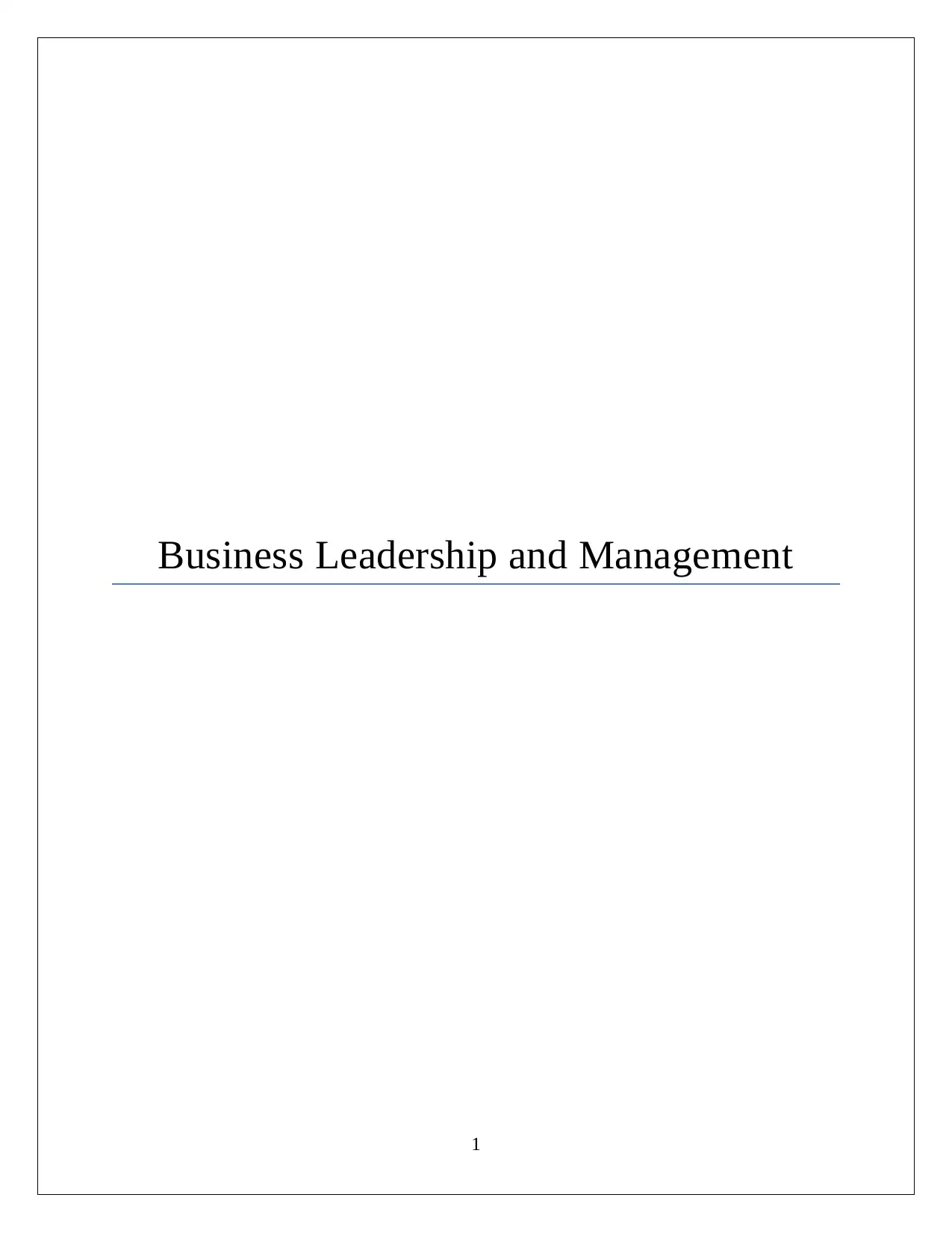
Business Leadership and Management
1
1
Paraphrase This Document
Need a fresh take? Get an instant paraphrase of this document with our AI Paraphraser
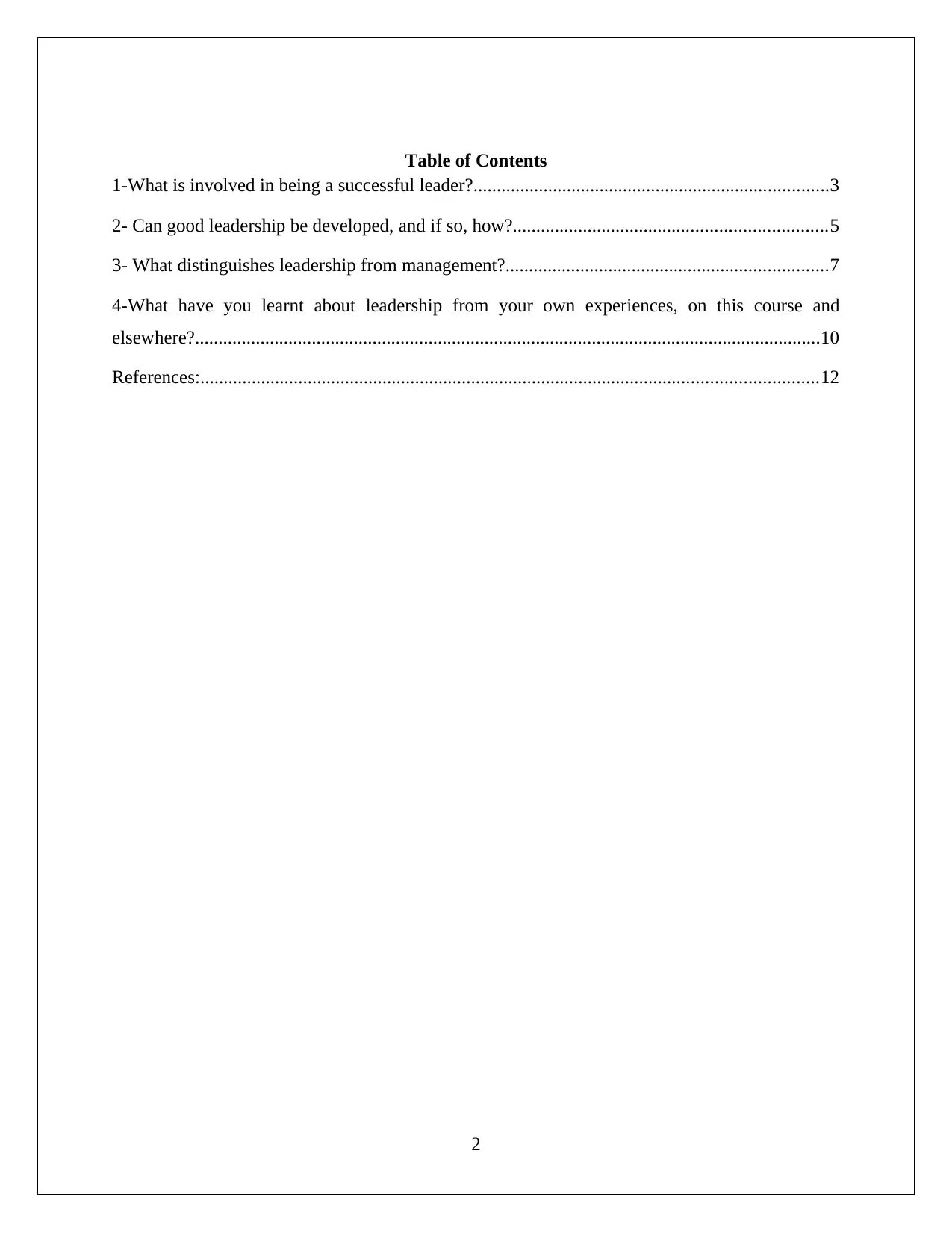
Table of Contents
1-What is involved in being a successful leader?............................................................................3
2- Can good leadership be developed, and if so, how?...................................................................5
3- What distinguishes leadership from management?.....................................................................7
4-What have you learnt about leadership from your own experiences, on this course and
elsewhere?......................................................................................................................................10
References:....................................................................................................................................12
2
1-What is involved in being a successful leader?............................................................................3
2- Can good leadership be developed, and if so, how?...................................................................5
3- What distinguishes leadership from management?.....................................................................7
4-What have you learnt about leadership from your own experiences, on this course and
elsewhere?......................................................................................................................................10
References:....................................................................................................................................12
2
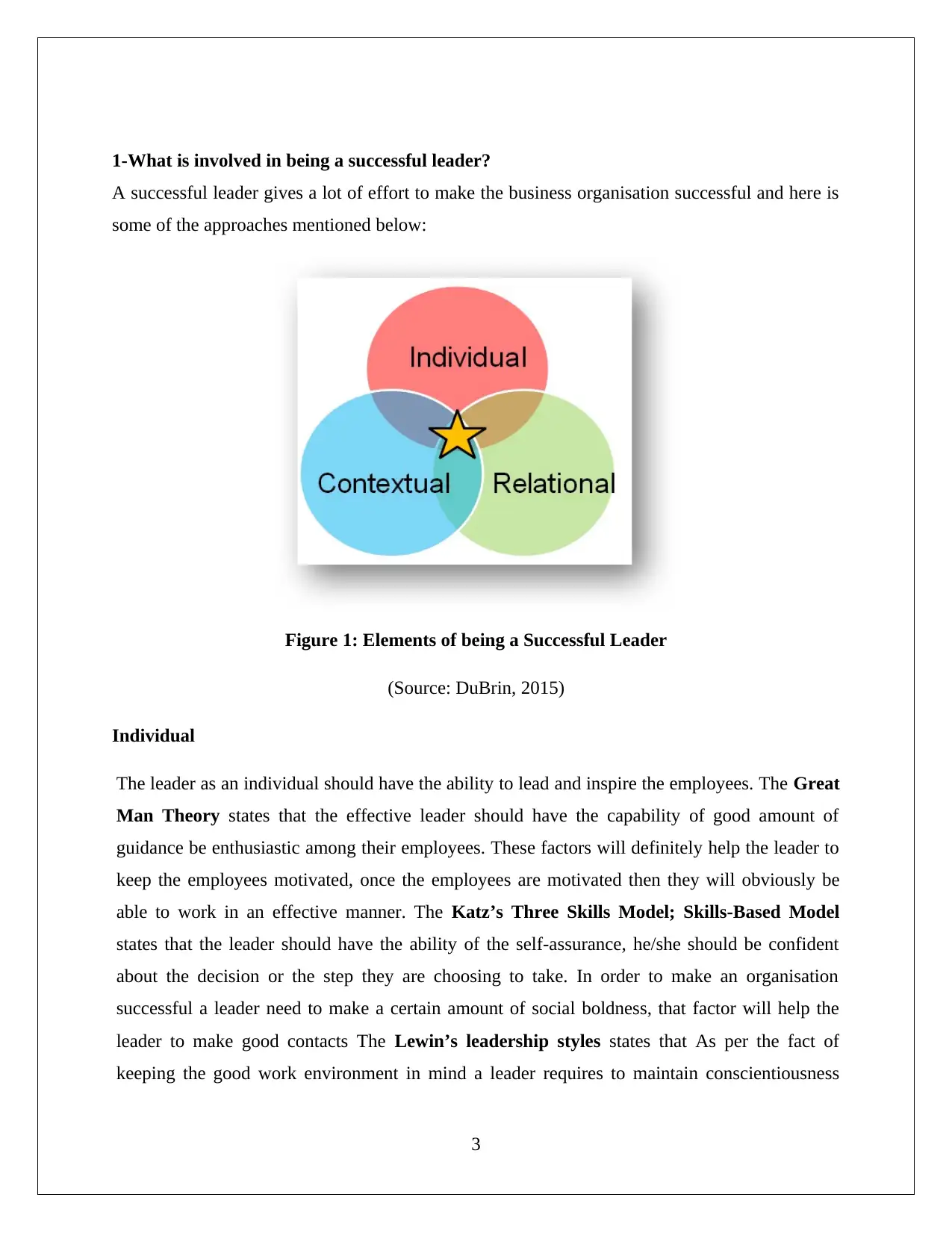
1-What is involved in being a successful leader?
A successful leader gives a lot of effort to make the business organisation successful and here is
some of the approaches mentioned below:
Figure 1: Elements of being a Successful Leader
(Source: DuBrin, 2015)
Individual
The leader as an individual should have the ability to lead and inspire the employees. The Great
Man Theory states that the effective leader should have the capability of good amount of
guidance be enthusiastic among their employees. These factors will definitely help the leader to
keep the employees motivated, once the employees are motivated then they will obviously be
able to work in an effective manner. The Katz’s Three Skills Model; Skills-Based Model
states that the leader should have the ability of the self-assurance, he/she should be confident
about the decision or the step they are choosing to take. In order to make an organisation
successful a leader need to make a certain amount of social boldness, that factor will help the
leader to make good contacts The Lewin’s leadership styles states that As per the fact of
keeping the good work environment in mind a leader requires to maintain conscientiousness
3
A successful leader gives a lot of effort to make the business organisation successful and here is
some of the approaches mentioned below:
Figure 1: Elements of being a Successful Leader
(Source: DuBrin, 2015)
Individual
The leader as an individual should have the ability to lead and inspire the employees. The Great
Man Theory states that the effective leader should have the capability of good amount of
guidance be enthusiastic among their employees. These factors will definitely help the leader to
keep the employees motivated, once the employees are motivated then they will obviously be
able to work in an effective manner. The Katz’s Three Skills Model; Skills-Based Model
states that the leader should have the ability of the self-assurance, he/she should be confident
about the decision or the step they are choosing to take. In order to make an organisation
successful a leader need to make a certain amount of social boldness, that factor will help the
leader to make good contacts The Lewin’s leadership styles states that As per the fact of
keeping the good work environment in mind a leader requires to maintain conscientiousness
3
⊘ This is a preview!⊘
Do you want full access?
Subscribe today to unlock all pages.

Trusted by 1+ million students worldwide
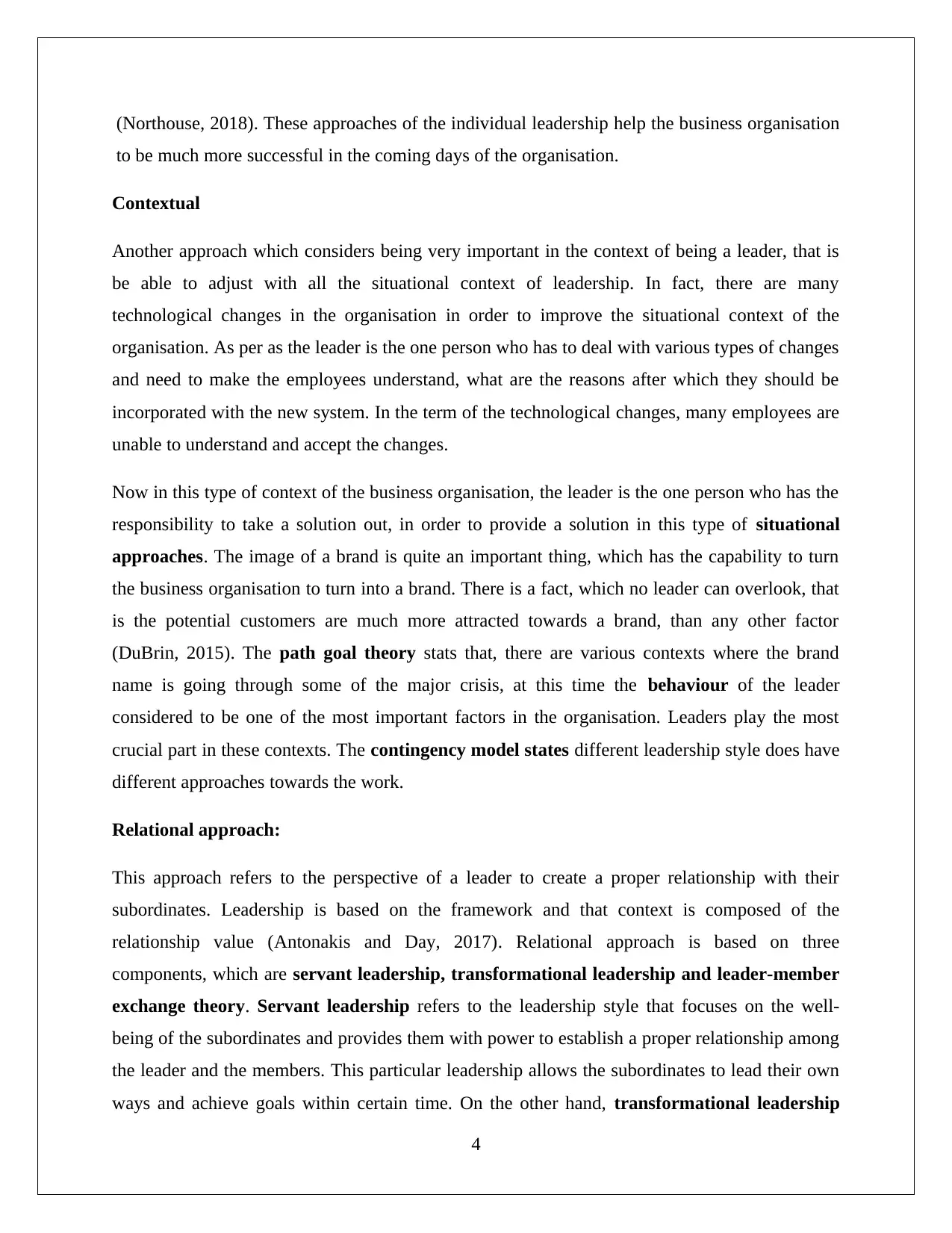
(Northouse, 2018). These approaches of the individual leadership help the business organisation
to be much more successful in the coming days of the organisation.
Contextual
Another approach which considers being very important in the context of being a leader, that is
be able to adjust with all the situational context of leadership. In fact, there are many
technological changes in the organisation in order to improve the situational context of the
organisation. As per as the leader is the one person who has to deal with various types of changes
and need to make the employees understand, what are the reasons after which they should be
incorporated with the new system. In the term of the technological changes, many employees are
unable to understand and accept the changes.
Now in this type of context of the business organisation, the leader is the one person who has the
responsibility to take a solution out, in order to provide a solution in this type of situational
approaches. The image of a brand is quite an important thing, which has the capability to turn
the business organisation to turn into a brand. There is a fact, which no leader can overlook, that
is the potential customers are much more attracted towards a brand, than any other factor
(DuBrin, 2015). The path goal theory stats that, there are various contexts where the brand
name is going through some of the major crisis, at this time the behaviour of the leader
considered to be one of the most important factors in the organisation. Leaders play the most
crucial part in these contexts. The contingency model states different leadership style does have
different approaches towards the work.
Relational approach:
This approach refers to the perspective of a leader to create a proper relationship with their
subordinates. Leadership is based on the framework and that context is composed of the
relationship value (Antonakis and Day, 2017). Relational approach is based on three
components, which are servant leadership, transformational leadership and leader-member
exchange theory. Servant leadership refers to the leadership style that focuses on the well-
being of the subordinates and provides them with power to establish a proper relationship among
the leader and the members. This particular leadership allows the subordinates to lead their own
ways and achieve goals within certain time. On the other hand, transformational leadership
4
to be much more successful in the coming days of the organisation.
Contextual
Another approach which considers being very important in the context of being a leader, that is
be able to adjust with all the situational context of leadership. In fact, there are many
technological changes in the organisation in order to improve the situational context of the
organisation. As per as the leader is the one person who has to deal with various types of changes
and need to make the employees understand, what are the reasons after which they should be
incorporated with the new system. In the term of the technological changes, many employees are
unable to understand and accept the changes.
Now in this type of context of the business organisation, the leader is the one person who has the
responsibility to take a solution out, in order to provide a solution in this type of situational
approaches. The image of a brand is quite an important thing, which has the capability to turn
the business organisation to turn into a brand. There is a fact, which no leader can overlook, that
is the potential customers are much more attracted towards a brand, than any other factor
(DuBrin, 2015). The path goal theory stats that, there are various contexts where the brand
name is going through some of the major crisis, at this time the behaviour of the leader
considered to be one of the most important factors in the organisation. Leaders play the most
crucial part in these contexts. The contingency model states different leadership style does have
different approaches towards the work.
Relational approach:
This approach refers to the perspective of a leader to create a proper relationship with their
subordinates. Leadership is based on the framework and that context is composed of the
relationship value (Antonakis and Day, 2017). Relational approach is based on three
components, which are servant leadership, transformational leadership and leader-member
exchange theory. Servant leadership refers to the leadership style that focuses on the well-
being of the subordinates and provides them with power to establish a proper relationship among
the leader and the members. This particular leadership allows the subordinates to lead their own
ways and achieve goals within certain time. On the other hand, transformational leadership
4
Paraphrase This Document
Need a fresh take? Get an instant paraphrase of this document with our AI Paraphraser
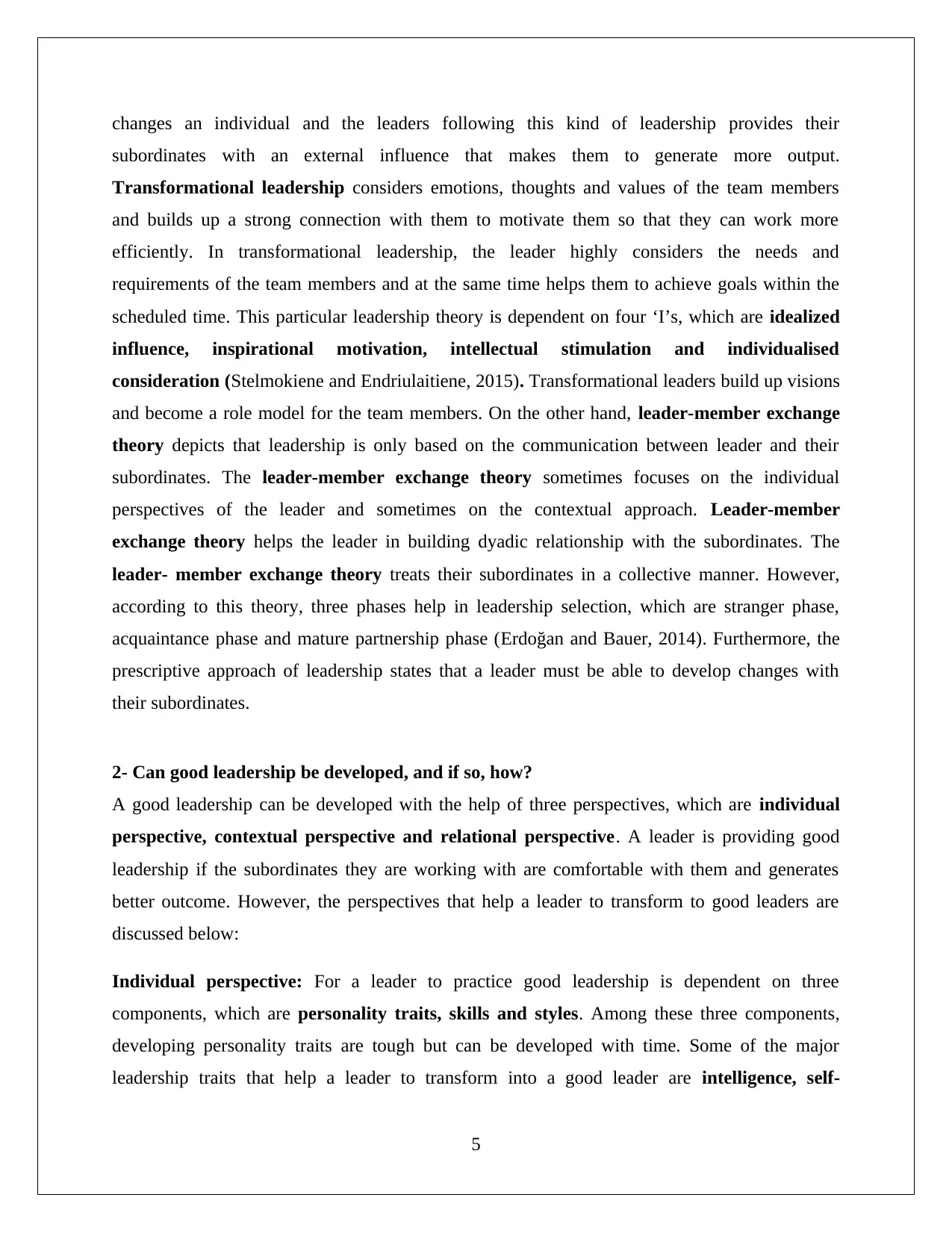
changes an individual and the leaders following this kind of leadership provides their
subordinates with an external influence that makes them to generate more output.
Transformational leadership considers emotions, thoughts and values of the team members
and builds up a strong connection with them to motivate them so that they can work more
efficiently. In transformational leadership, the leader highly considers the needs and
requirements of the team members and at the same time helps them to achieve goals within the
scheduled time. This particular leadership theory is dependent on four ‘I’s, which are idealized
influence, inspirational motivation, intellectual stimulation and individualised
consideration (Stelmokiene and Endriulaitiene, 2015). Transformational leaders build up visions
and become a role model for the team members. On the other hand, leader-member exchange
theory depicts that leadership is only based on the communication between leader and their
subordinates. The leader-member exchange theory sometimes focuses on the individual
perspectives of the leader and sometimes on the contextual approach. Leader-member
exchange theory helps the leader in building dyadic relationship with the subordinates. The
leader- member exchange theory treats their subordinates in a collective manner. However,
according to this theory, three phases help in leadership selection, which are stranger phase,
acquaintance phase and mature partnership phase (Erdoğan and Bauer, 2014). Furthermore, the
prescriptive approach of leadership states that a leader must be able to develop changes with
their subordinates.
2- Can good leadership be developed, and if so, how?
A good leadership can be developed with the help of three perspectives, which are individual
perspective, contextual perspective and relational perspective. A leader is providing good
leadership if the subordinates they are working with are comfortable with them and generates
better outcome. However, the perspectives that help a leader to transform to good leaders are
discussed below:
Individual perspective: For a leader to practice good leadership is dependent on three
components, which are personality traits, skills and styles. Among these three components,
developing personality traits are tough but can be developed with time. Some of the major
leadership traits that help a leader to transform into a good leader are intelligence, self-
5
subordinates with an external influence that makes them to generate more output.
Transformational leadership considers emotions, thoughts and values of the team members
and builds up a strong connection with them to motivate them so that they can work more
efficiently. In transformational leadership, the leader highly considers the needs and
requirements of the team members and at the same time helps them to achieve goals within the
scheduled time. This particular leadership theory is dependent on four ‘I’s, which are idealized
influence, inspirational motivation, intellectual stimulation and individualised
consideration (Stelmokiene and Endriulaitiene, 2015). Transformational leaders build up visions
and become a role model for the team members. On the other hand, leader-member exchange
theory depicts that leadership is only based on the communication between leader and their
subordinates. The leader-member exchange theory sometimes focuses on the individual
perspectives of the leader and sometimes on the contextual approach. Leader-member
exchange theory helps the leader in building dyadic relationship with the subordinates. The
leader- member exchange theory treats their subordinates in a collective manner. However,
according to this theory, three phases help in leadership selection, which are stranger phase,
acquaintance phase and mature partnership phase (Erdoğan and Bauer, 2014). Furthermore, the
prescriptive approach of leadership states that a leader must be able to develop changes with
their subordinates.
2- Can good leadership be developed, and if so, how?
A good leadership can be developed with the help of three perspectives, which are individual
perspective, contextual perspective and relational perspective. A leader is providing good
leadership if the subordinates they are working with are comfortable with them and generates
better outcome. However, the perspectives that help a leader to transform to good leaders are
discussed below:
Individual perspective: For a leader to practice good leadership is dependent on three
components, which are personality traits, skills and styles. Among these three components,
developing personality traits are tough but can be developed with time. Some of the major
leadership traits that help a leader to transform into a good leader are intelligence, self-
5
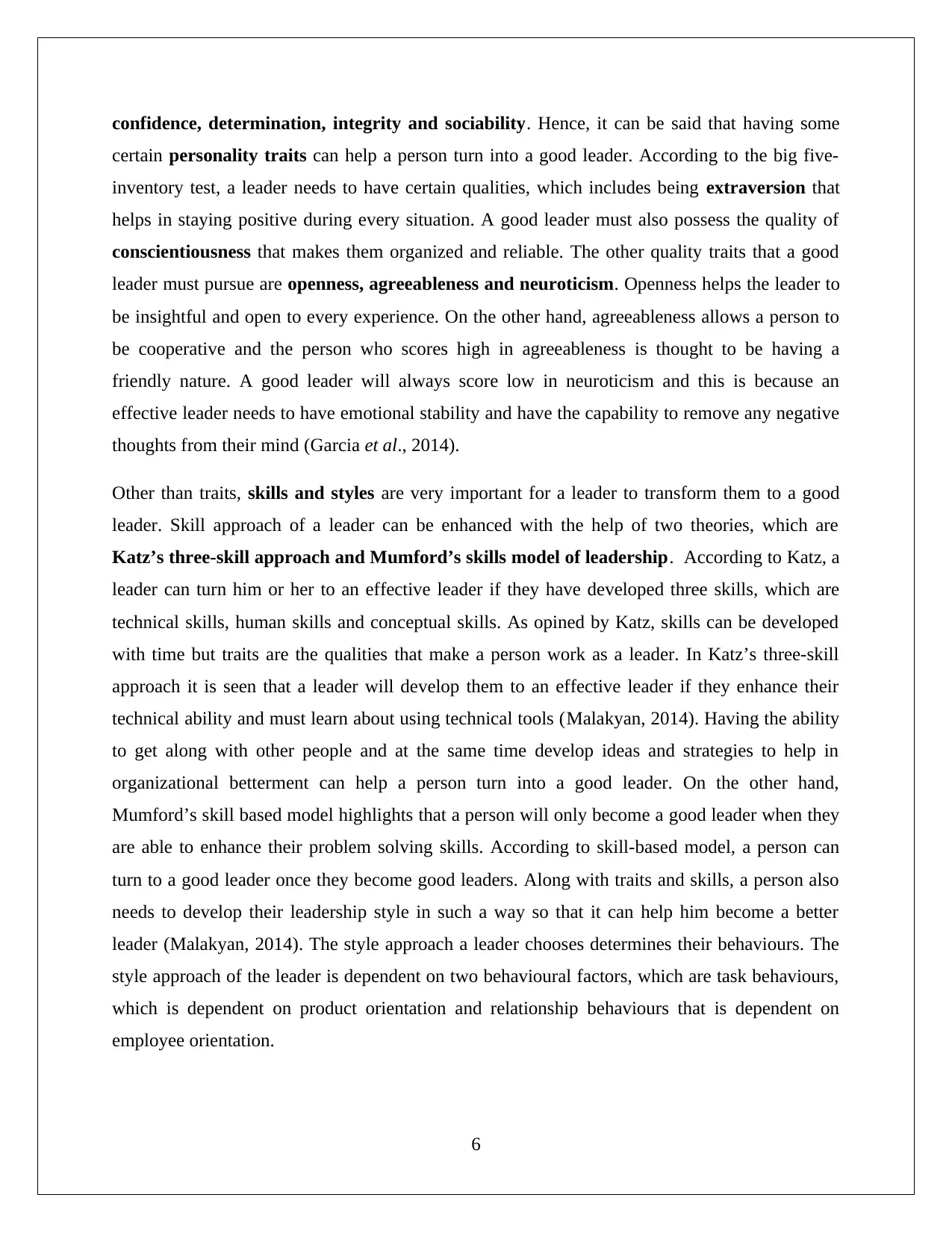
confidence, determination, integrity and sociability. Hence, it can be said that having some
certain personality traits can help a person turn into a good leader. According to the big five-
inventory test, a leader needs to have certain qualities, which includes being extraversion that
helps in staying positive during every situation. A good leader must also possess the quality of
conscientiousness that makes them organized and reliable. The other quality traits that a good
leader must pursue are openness, agreeableness and neuroticism. Openness helps the leader to
be insightful and open to every experience. On the other hand, agreeableness allows a person to
be cooperative and the person who scores high in agreeableness is thought to be having a
friendly nature. A good leader will always score low in neuroticism and this is because an
effective leader needs to have emotional stability and have the capability to remove any negative
thoughts from their mind (Garcia et al., 2014).
Other than traits, skills and styles are very important for a leader to transform them to a good
leader. Skill approach of a leader can be enhanced with the help of two theories, which are
Katz’s three-skill approach and Mumford’s skills model of leadership. According to Katz, a
leader can turn him or her to an effective leader if they have developed three skills, which are
technical skills, human skills and conceptual skills. As opined by Katz, skills can be developed
with time but traits are the qualities that make a person work as a leader. In Katz’s three-skill
approach it is seen that a leader will develop them to an effective leader if they enhance their
technical ability and must learn about using technical tools (Malakyan, 2014). Having the ability
to get along with other people and at the same time develop ideas and strategies to help in
organizational betterment can help a person turn into a good leader. On the other hand,
Mumford’s skill based model highlights that a person will only become a good leader when they
are able to enhance their problem solving skills. According to skill-based model, a person can
turn to a good leader once they become good leaders. Along with traits and skills, a person also
needs to develop their leadership style in such a way so that it can help him become a better
leader (Malakyan, 2014). The style approach a leader chooses determines their behaviours. The
style approach of the leader is dependent on two behavioural factors, which are task behaviours,
which is dependent on product orientation and relationship behaviours that is dependent on
employee orientation.
6
certain personality traits can help a person turn into a good leader. According to the big five-
inventory test, a leader needs to have certain qualities, which includes being extraversion that
helps in staying positive during every situation. A good leader must also possess the quality of
conscientiousness that makes them organized and reliable. The other quality traits that a good
leader must pursue are openness, agreeableness and neuroticism. Openness helps the leader to
be insightful and open to every experience. On the other hand, agreeableness allows a person to
be cooperative and the person who scores high in agreeableness is thought to be having a
friendly nature. A good leader will always score low in neuroticism and this is because an
effective leader needs to have emotional stability and have the capability to remove any negative
thoughts from their mind (Garcia et al., 2014).
Other than traits, skills and styles are very important for a leader to transform them to a good
leader. Skill approach of a leader can be enhanced with the help of two theories, which are
Katz’s three-skill approach and Mumford’s skills model of leadership. According to Katz, a
leader can turn him or her to an effective leader if they have developed three skills, which are
technical skills, human skills and conceptual skills. As opined by Katz, skills can be developed
with time but traits are the qualities that make a person work as a leader. In Katz’s three-skill
approach it is seen that a leader will develop them to an effective leader if they enhance their
technical ability and must learn about using technical tools (Malakyan, 2014). Having the ability
to get along with other people and at the same time develop ideas and strategies to help in
organizational betterment can help a person turn into a good leader. On the other hand,
Mumford’s skill based model highlights that a person will only become a good leader when they
are able to enhance their problem solving skills. According to skill-based model, a person can
turn to a good leader once they become good leaders. Along with traits and skills, a person also
needs to develop their leadership style in such a way so that it can help him become a better
leader (Malakyan, 2014). The style approach a leader chooses determines their behaviours. The
style approach of the leader is dependent on two behavioural factors, which are task behaviours,
which is dependent on product orientation and relationship behaviours that is dependent on
employee orientation.
6
⊘ This is a preview!⊘
Do you want full access?
Subscribe today to unlock all pages.

Trusted by 1+ million students worldwide
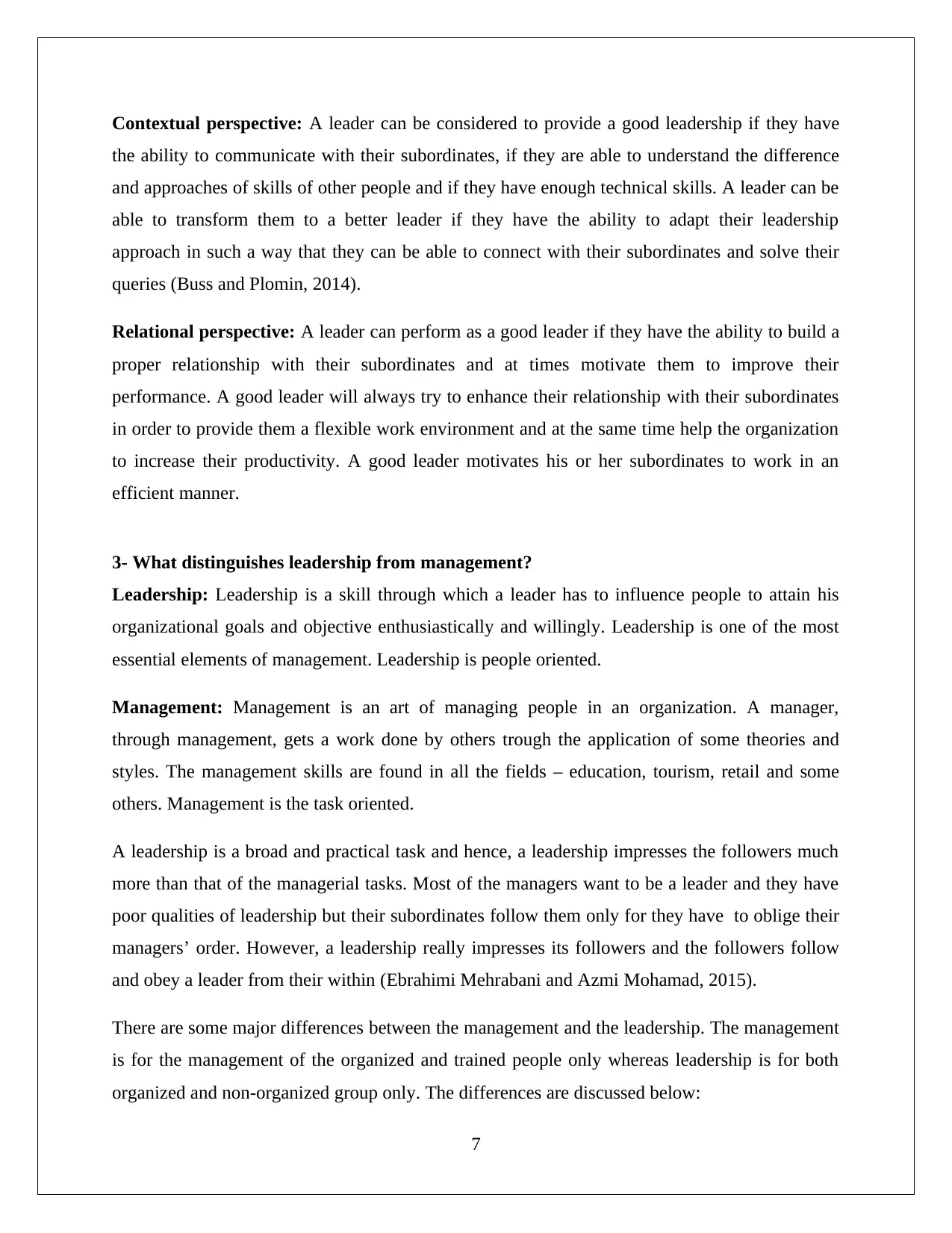
Contextual perspective: A leader can be considered to provide a good leadership if they have
the ability to communicate with their subordinates, if they are able to understand the difference
and approaches of skills of other people and if they have enough technical skills. A leader can be
able to transform them to a better leader if they have the ability to adapt their leadership
approach in such a way that they can be able to connect with their subordinates and solve their
queries (Buss and Plomin, 2014).
Relational perspective: A leader can perform as a good leader if they have the ability to build a
proper relationship with their subordinates and at times motivate them to improve their
performance. A good leader will always try to enhance their relationship with their subordinates
in order to provide them a flexible work environment and at the same time help the organization
to increase their productivity. A good leader motivates his or her subordinates to work in an
efficient manner.
3- What distinguishes leadership from management?
Leadership: Leadership is a skill through which a leader has to influence people to attain his
organizational goals and objective enthusiastically and willingly. Leadership is one of the most
essential elements of management. Leadership is people oriented.
Management: Management is an art of managing people in an organization. A manager,
through management, gets a work done by others trough the application of some theories and
styles. The management skills are found in all the fields – education, tourism, retail and some
others. Management is the task oriented.
A leadership is a broad and practical task and hence, a leadership impresses the followers much
more than that of the managerial tasks. Most of the managers want to be a leader and they have
poor qualities of leadership but their subordinates follow them only for they have to oblige their
managers’ order. However, a leadership really impresses its followers and the followers follow
and obey a leader from their within (Ebrahimi Mehrabani and Azmi Mohamad, 2015).
There are some major differences between the management and the leadership. The management
is for the management of the organized and trained people only whereas leadership is for both
organized and non-organized group only. The differences are discussed below:
7
the ability to communicate with their subordinates, if they are able to understand the difference
and approaches of skills of other people and if they have enough technical skills. A leader can be
able to transform them to a better leader if they have the ability to adapt their leadership
approach in such a way that they can be able to connect with their subordinates and solve their
queries (Buss and Plomin, 2014).
Relational perspective: A leader can perform as a good leader if they have the ability to build a
proper relationship with their subordinates and at times motivate them to improve their
performance. A good leader will always try to enhance their relationship with their subordinates
in order to provide them a flexible work environment and at the same time help the organization
to increase their productivity. A good leader motivates his or her subordinates to work in an
efficient manner.
3- What distinguishes leadership from management?
Leadership: Leadership is a skill through which a leader has to influence people to attain his
organizational goals and objective enthusiastically and willingly. Leadership is one of the most
essential elements of management. Leadership is people oriented.
Management: Management is an art of managing people in an organization. A manager,
through management, gets a work done by others trough the application of some theories and
styles. The management skills are found in all the fields – education, tourism, retail and some
others. Management is the task oriented.
A leadership is a broad and practical task and hence, a leadership impresses the followers much
more than that of the managerial tasks. Most of the managers want to be a leader and they have
poor qualities of leadership but their subordinates follow them only for they have to oblige their
managers’ order. However, a leadership really impresses its followers and the followers follow
and obey a leader from their within (Ebrahimi Mehrabani and Azmi Mohamad, 2015).
There are some major differences between the management and the leadership. The management
is for the management of the organized and trained people only whereas leadership is for both
organized and non-organized group only. The differences are discussed below:
7
Paraphrase This Document
Need a fresh take? Get an instant paraphrase of this document with our AI Paraphraser
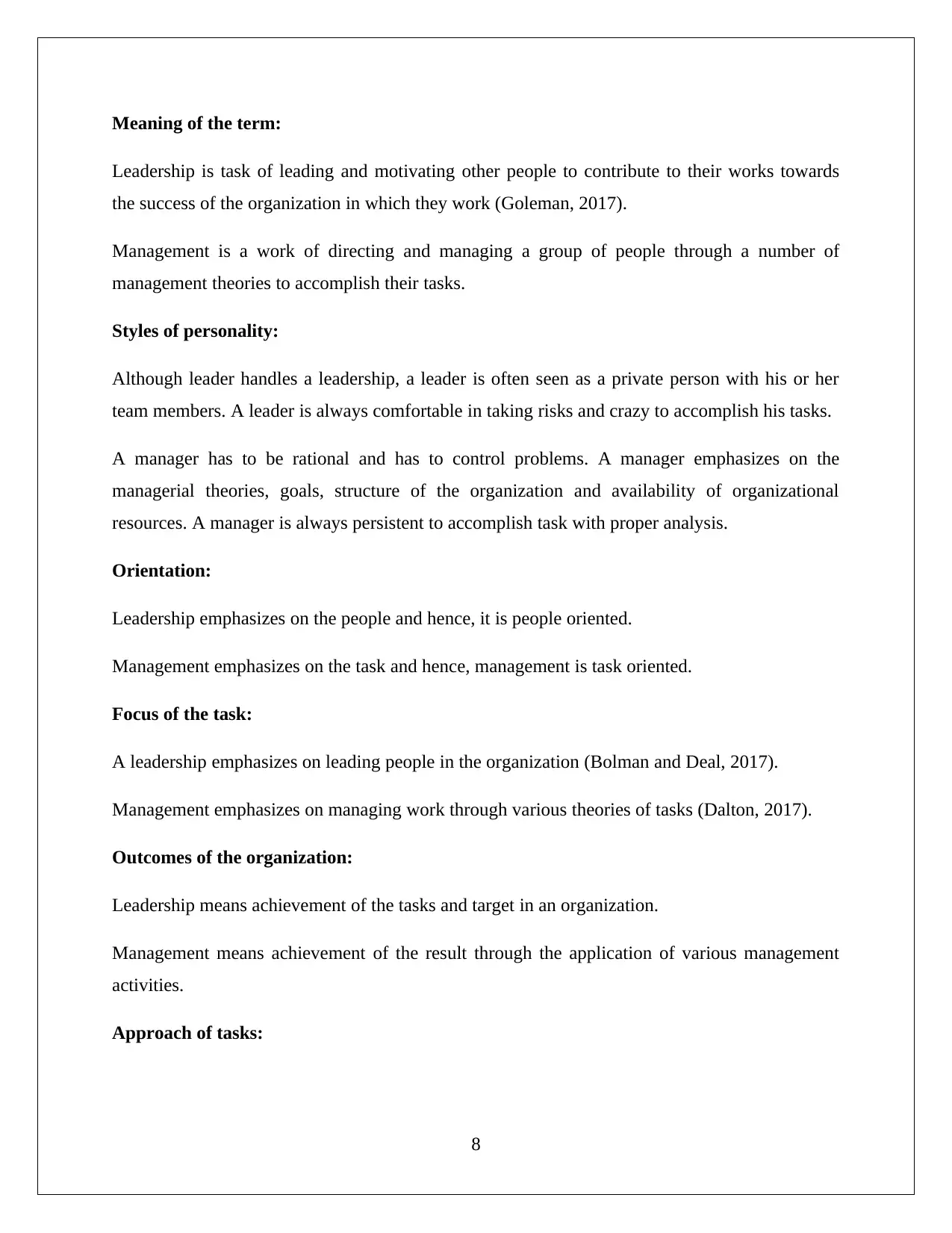
Meaning of the term:
Leadership is task of leading and motivating other people to contribute to their works towards
the success of the organization in which they work (Goleman, 2017).
Management is a work of directing and managing a group of people through a number of
management theories to accomplish their tasks.
Styles of personality:
Although leader handles a leadership, a leader is often seen as a private person with his or her
team members. A leader is always comfortable in taking risks and crazy to accomplish his tasks.
A manager has to be rational and has to control problems. A manager emphasizes on the
managerial theories, goals, structure of the organization and availability of organizational
resources. A manager is always persistent to accomplish task with proper analysis.
Orientation:
Leadership emphasizes on the people and hence, it is people oriented.
Management emphasizes on the task and hence, management is task oriented.
Focus of the task:
A leadership emphasizes on leading people in the organization (Bolman and Deal, 2017).
Management emphasizes on managing work through various theories of tasks (Dalton, 2017).
Outcomes of the organization:
Leadership means achievement of the tasks and target in an organization.
Management means achievement of the result through the application of various management
activities.
Approach of tasks:
8
Leadership is task of leading and motivating other people to contribute to their works towards
the success of the organization in which they work (Goleman, 2017).
Management is a work of directing and managing a group of people through a number of
management theories to accomplish their tasks.
Styles of personality:
Although leader handles a leadership, a leader is often seen as a private person with his or her
team members. A leader is always comfortable in taking risks and crazy to accomplish his tasks.
A manager has to be rational and has to control problems. A manager emphasizes on the
managerial theories, goals, structure of the organization and availability of organizational
resources. A manager is always persistent to accomplish task with proper analysis.
Orientation:
Leadership emphasizes on the people and hence, it is people oriented.
Management emphasizes on the task and hence, management is task oriented.
Focus of the task:
A leadership emphasizes on leading people in the organization (Bolman and Deal, 2017).
Management emphasizes on managing work through various theories of tasks (Dalton, 2017).
Outcomes of the organization:
Leadership means achievement of the tasks and target in an organization.
Management means achievement of the result through the application of various management
activities.
Approach of tasks:
8
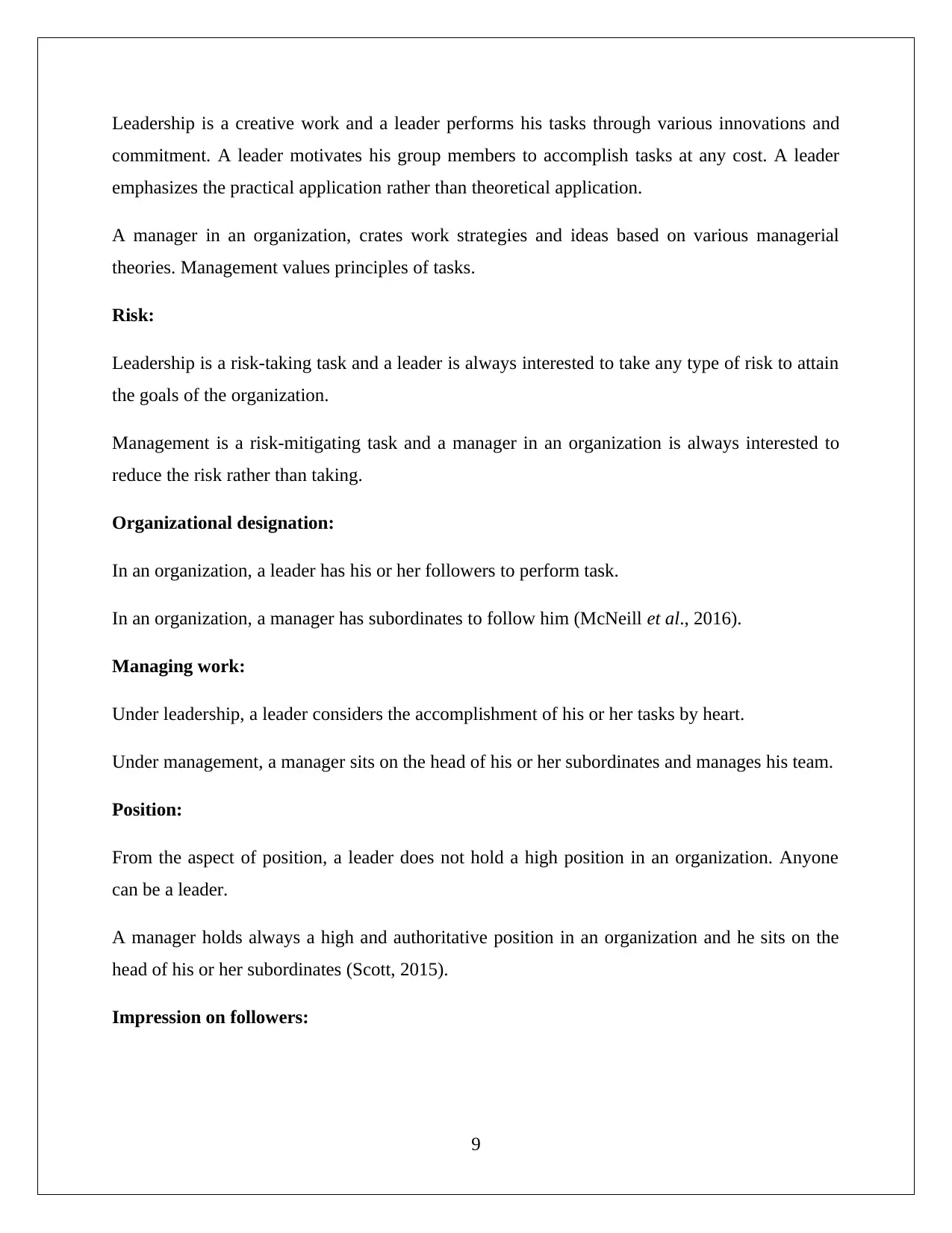
Leadership is a creative work and a leader performs his tasks through various innovations and
commitment. A leader motivates his group members to accomplish tasks at any cost. A leader
emphasizes the practical application rather than theoretical application.
A manager in an organization, crates work strategies and ideas based on various managerial
theories. Management values principles of tasks.
Risk:
Leadership is a risk-taking task and a leader is always interested to take any type of risk to attain
the goals of the organization.
Management is a risk-mitigating task and a manager in an organization is always interested to
reduce the risk rather than taking.
Organizational designation:
In an organization, a leader has his or her followers to perform task.
In an organization, a manager has subordinates to follow him (McNeill et al., 2016).
Managing work:
Under leadership, a leader considers the accomplishment of his or her tasks by heart.
Under management, a manager sits on the head of his or her subordinates and manages his team.
Position:
From the aspect of position, a leader does not hold a high position in an organization. Anyone
can be a leader.
A manager holds always a high and authoritative position in an organization and he sits on the
head of his or her subordinates (Scott, 2015).
Impression on followers:
9
commitment. A leader motivates his group members to accomplish tasks at any cost. A leader
emphasizes the practical application rather than theoretical application.
A manager in an organization, crates work strategies and ideas based on various managerial
theories. Management values principles of tasks.
Risk:
Leadership is a risk-taking task and a leader is always interested to take any type of risk to attain
the goals of the organization.
Management is a risk-mitigating task and a manager in an organization is always interested to
reduce the risk rather than taking.
Organizational designation:
In an organization, a leader has his or her followers to perform task.
In an organization, a manager has subordinates to follow him (McNeill et al., 2016).
Managing work:
Under leadership, a leader considers the accomplishment of his or her tasks by heart.
Under management, a manager sits on the head of his or her subordinates and manages his team.
Position:
From the aspect of position, a leader does not hold a high position in an organization. Anyone
can be a leader.
A manager holds always a high and authoritative position in an organization and he sits on the
head of his or her subordinates (Scott, 2015).
Impression on followers:
9
⊘ This is a preview!⊘
Do you want full access?
Subscribe today to unlock all pages.

Trusted by 1+ million students worldwide
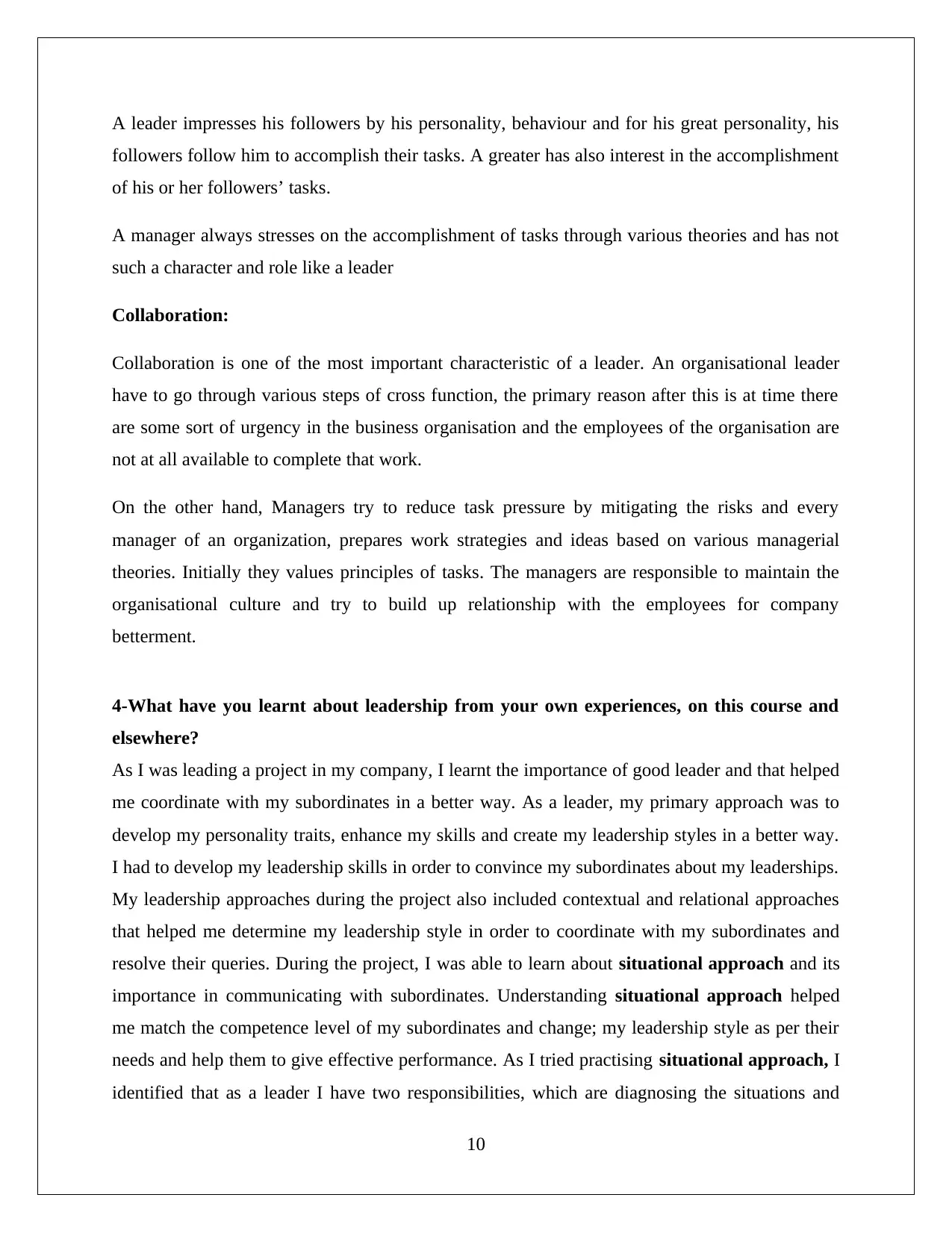
A leader impresses his followers by his personality, behaviour and for his great personality, his
followers follow him to accomplish their tasks. A greater has also interest in the accomplishment
of his or her followers’ tasks.
A manager always stresses on the accomplishment of tasks through various theories and has not
such a character and role like a leader
Collaboration:
Collaboration is one of the most important characteristic of a leader. An organisational leader
have to go through various steps of cross function, the primary reason after this is at time there
are some sort of urgency in the business organisation and the employees of the organisation are
not at all available to complete that work.
On the other hand, Managers try to reduce task pressure by mitigating the risks and every
manager of an organization, prepares work strategies and ideas based on various managerial
theories. Initially they values principles of tasks. The managers are responsible to maintain the
organisational culture and try to build up relationship with the employees for company
betterment.
4-What have you learnt about leadership from your own experiences, on this course and
elsewhere?
As I was leading a project in my company, I learnt the importance of good leader and that helped
me coordinate with my subordinates in a better way. As a leader, my primary approach was to
develop my personality traits, enhance my skills and create my leadership styles in a better way.
I had to develop my leadership skills in order to convince my subordinates about my leaderships.
My leadership approaches during the project also included contextual and relational approaches
that helped me determine my leadership style in order to coordinate with my subordinates and
resolve their queries. During the project, I was able to learn about situational approach and its
importance in communicating with subordinates. Understanding situational approach helped
me match the competence level of my subordinates and change; my leadership style as per their
needs and help them to give effective performance. As I tried practising situational approach, I
identified that as a leader I have two responsibilities, which are diagnosing the situations and
10
followers follow him to accomplish their tasks. A greater has also interest in the accomplishment
of his or her followers’ tasks.
A manager always stresses on the accomplishment of tasks through various theories and has not
such a character and role like a leader
Collaboration:
Collaboration is one of the most important characteristic of a leader. An organisational leader
have to go through various steps of cross function, the primary reason after this is at time there
are some sort of urgency in the business organisation and the employees of the organisation are
not at all available to complete that work.
On the other hand, Managers try to reduce task pressure by mitigating the risks and every
manager of an organization, prepares work strategies and ideas based on various managerial
theories. Initially they values principles of tasks. The managers are responsible to maintain the
organisational culture and try to build up relationship with the employees for company
betterment.
4-What have you learnt about leadership from your own experiences, on this course and
elsewhere?
As I was leading a project in my company, I learnt the importance of good leader and that helped
me coordinate with my subordinates in a better way. As a leader, my primary approach was to
develop my personality traits, enhance my skills and create my leadership styles in a better way.
I had to develop my leadership skills in order to convince my subordinates about my leaderships.
My leadership approaches during the project also included contextual and relational approaches
that helped me determine my leadership style in order to coordinate with my subordinates and
resolve their queries. During the project, I was able to learn about situational approach and its
importance in communicating with subordinates. Understanding situational approach helped
me match the competence level of my subordinates and change; my leadership style as per their
needs and help them to give effective performance. As I tried practising situational approach, I
identified that as a leader I have two responsibilities, which are diagnosing the situations and
10
Paraphrase This Document
Need a fresh take? Get an instant paraphrase of this document with our AI Paraphraser
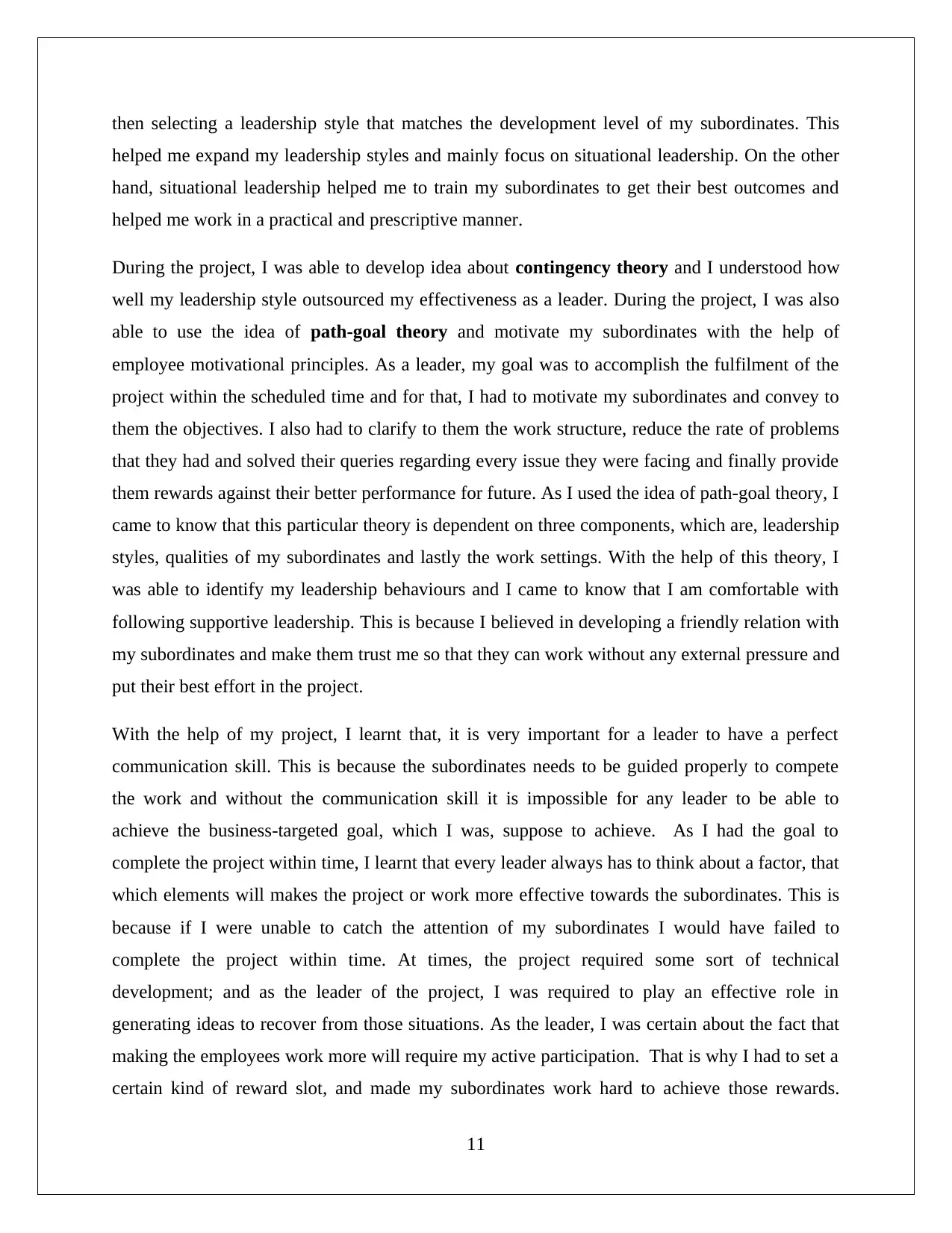
then selecting a leadership style that matches the development level of my subordinates. This
helped me expand my leadership styles and mainly focus on situational leadership. On the other
hand, situational leadership helped me to train my subordinates to get their best outcomes and
helped me work in a practical and prescriptive manner.
During the project, I was able to develop idea about contingency theory and I understood how
well my leadership style outsourced my effectiveness as a leader. During the project, I was also
able to use the idea of path-goal theory and motivate my subordinates with the help of
employee motivational principles. As a leader, my goal was to accomplish the fulfilment of the
project within the scheduled time and for that, I had to motivate my subordinates and convey to
them the objectives. I also had to clarify to them the work structure, reduce the rate of problems
that they had and solved their queries regarding every issue they were facing and finally provide
them rewards against their better performance for future. As I used the idea of path-goal theory, I
came to know that this particular theory is dependent on three components, which are, leadership
styles, qualities of my subordinates and lastly the work settings. With the help of this theory, I
was able to identify my leadership behaviours and I came to know that I am comfortable with
following supportive leadership. This is because I believed in developing a friendly relation with
my subordinates and make them trust me so that they can work without any external pressure and
put their best effort in the project.
With the help of my project, I learnt that, it is very important for a leader to have a perfect
communication skill. This is because the subordinates needs to be guided properly to compete
the work and without the communication skill it is impossible for any leader to be able to
achieve the business-targeted goal, which I was, suppose to achieve. As I had the goal to
complete the project within time, I learnt that every leader always has to think about a factor, that
which elements will makes the project or work more effective towards the subordinates. This is
because if I were unable to catch the attention of my subordinates I would have failed to
complete the project within time. At times, the project required some sort of technical
development; and as the leader of the project, I was required to play an effective role in
generating ideas to recover from those situations. As the leader, I was certain about the fact that
making the employees work more will require my active participation. That is why I had to set a
certain kind of reward slot, and made my subordinates work hard to achieve those rewards.
11
helped me expand my leadership styles and mainly focus on situational leadership. On the other
hand, situational leadership helped me to train my subordinates to get their best outcomes and
helped me work in a practical and prescriptive manner.
During the project, I was able to develop idea about contingency theory and I understood how
well my leadership style outsourced my effectiveness as a leader. During the project, I was also
able to use the idea of path-goal theory and motivate my subordinates with the help of
employee motivational principles. As a leader, my goal was to accomplish the fulfilment of the
project within the scheduled time and for that, I had to motivate my subordinates and convey to
them the objectives. I also had to clarify to them the work structure, reduce the rate of problems
that they had and solved their queries regarding every issue they were facing and finally provide
them rewards against their better performance for future. As I used the idea of path-goal theory, I
came to know that this particular theory is dependent on three components, which are, leadership
styles, qualities of my subordinates and lastly the work settings. With the help of this theory, I
was able to identify my leadership behaviours and I came to know that I am comfortable with
following supportive leadership. This is because I believed in developing a friendly relation with
my subordinates and make them trust me so that they can work without any external pressure and
put their best effort in the project.
With the help of my project, I learnt that, it is very important for a leader to have a perfect
communication skill. This is because the subordinates needs to be guided properly to compete
the work and without the communication skill it is impossible for any leader to be able to
achieve the business-targeted goal, which I was, suppose to achieve. As I had the goal to
complete the project within time, I learnt that every leader always has to think about a factor, that
which elements will makes the project or work more effective towards the subordinates. This is
because if I were unable to catch the attention of my subordinates I would have failed to
complete the project within time. At times, the project required some sort of technical
development; and as the leader of the project, I was required to play an effective role in
generating ideas to recover from those situations. As the leader, I was certain about the fact that
making the employees work more will require my active participation. That is why I had to set a
certain kind of reward slot, and made my subordinates work hard to achieve those rewards.
11

During the project, I was able to shape up my idea about the role managers play and determine
how their responsibilities are different from a leader’s responsibilities. My experience as a whole
was very explanatory and I will be able to use these learning in the future to guide my
subordinates and make them work hard in my upcoming projects and help my company reach
their specific goals.
12
how their responsibilities are different from a leader’s responsibilities. My experience as a whole
was very explanatory and I will be able to use these learning in the future to guide my
subordinates and make them work hard in my upcoming projects and help my company reach
their specific goals.
12
⊘ This is a preview!⊘
Do you want full access?
Subscribe today to unlock all pages.

Trusted by 1+ million students worldwide
1 out of 14
Related Documents
Your All-in-One AI-Powered Toolkit for Academic Success.
+13062052269
info@desklib.com
Available 24*7 on WhatsApp / Email
![[object Object]](/_next/static/media/star-bottom.7253800d.svg)
Unlock your academic potential
Copyright © 2020–2025 A2Z Services. All Rights Reserved. Developed and managed by ZUCOL.





